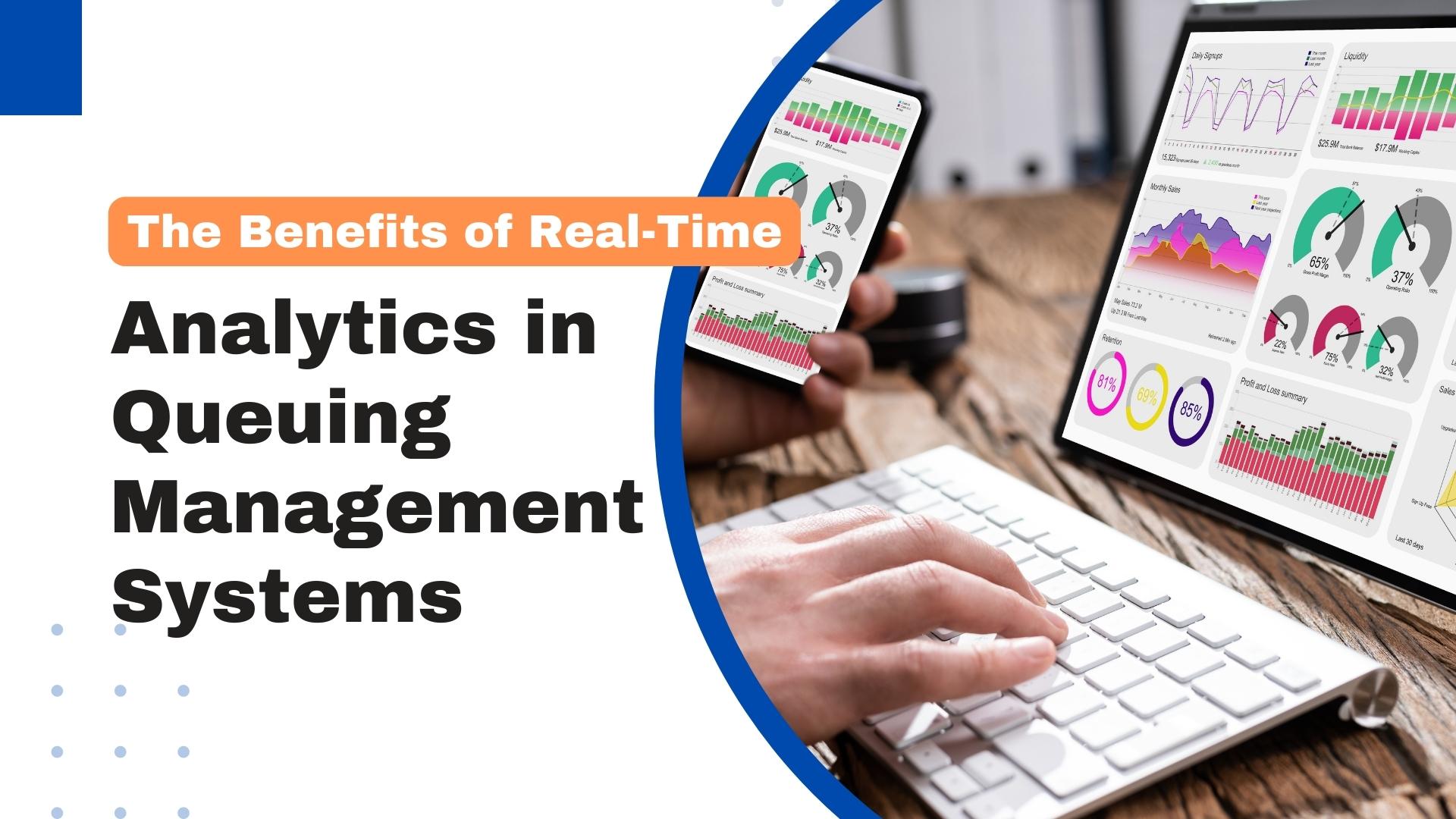Optimizing Your Customer Flow with a Queuing Management System In the relentless world of business, the efficient management of customer flow has …
The Benefits of Real-Time Analytics in Queuing Management Systems

Queuing management systems have become an integral part of many businesses, enabling them to manage customer flow, reduce wait times, and improve customer experience. However, as customer expectations continue to evolve, businesses are under increasing pressure to provide a seamless, efficient, and personalized service. This is where real-time analytics in queuing management systems come in, providing businesses with a wealth of data and insights that can help them optimize operations, enhance customer experience, and drive growth.
Real-time analytics in queuing management systems is a process that involves the collection, processing, and analysis of data in real-time, providing businesses with instant insights into customer behavior and operational performance. By leveraging real-time analytics, businesses can gain a competitive edge, as they are able to make data-driven decisions quickly and efficiently, ensuring that they meet customer needs and expectations.
In this article, we will explore the benefits of real-time analytics in queuing management systems, and how businesses can leverage this technology to improve operations and enhance customer experience.
1. Real-time Analytics Provides Immediate Insights
Real-time analytics in queuing management systems provides businesses with immediate insights into customer behavior, queue lengths, and wait times. By leveraging this data, businesses can optimize operations and reduce wait times, resulting in a better customer experience. For instance, real-time analytics can help businesses identify peak traffic times and adjust staffing accordingly, reducing wait times and ensuring a faster service.
In addition, real-time analytics can help businesses understand the factors that influence customer behavior and preferences, such as demographics, location, and time of day. This information can be used to tailor services and offerings to specific customer segments, enhancing the overall customer experience.
2. Real-time Analytics Enables Proactive Decision-making
Real-time analytics in queuing management systems enables proactive decision-making, as businesses can identify and address issues as they arise. By leveraging real-time analytics, businesses can detect bottlenecks in the queue, adjust staffing levels, and provide customers with accurate wait time estimates, all in real-time.
For example, if a queue is backing up due to a particular service being in high demand, real-time analytics can help businesses allocate additional resources to that service, reducing wait times and improving customer satisfaction. In addition, real-time analytics can help businesses detect and resolve issues with their queuing management system, such as malfunctioning equipment or staffing shortages, before they impact the customer experience.
3. Real-time Analytics Enhances Customer Experience
Real-time analytics in queuing management systems can significantly enhance the customer experience, by reducing wait times, providing accurate wait time estimates, and offering personalized services. By leveraging real-time analytics, businesses can optimize their queuing management systems to meet customer needs and preferences, resulting in a better overall experience.
For instance, businesses can leverage real-time analytics to implement virtual queuing, which allows customers to join a queue remotely and receive real-time updates on their position in the queue. This not only reduces wait times, but also enables customers to complete other tasks while they wait, improving the overall customer experience.
In addition, businesses can leverage real-time analytics to personalize services and offerings to specific customer segments, such as offering promotions or discounts to customers who have been waiting for a certain amount of time.
4. Real-time Analytics Improves Operational Efficiency
Real-time analytics in queuing management systems can significantly improve operational efficiency, by providing businesses with insights into staffing levels, service demand, and queue flow. By leveraging this data, businesses can optimize their operations, reducing wait times and improving overall efficiency.
For example, businesses can use real-time analytics to identify peak traffic times and adjust staffing levels accordingly, ensuring that they have the right number of staff to handle customer demand. In addition, real-time analytics can help businesses identify bottlenecks in the queue and adjust the flow of customers to reduce wait times.
5. Real-time Analytics Enables Continuous Improvement
Real-time analytics in queuing management systems enables continuous improvement, as businesses can analyze data in real-time and make data-driven decisions to optimize operations and enhance customer experience. By leveraging real-time analytics, businesses can identify areas for improvement and take action to address them, resulting in a better overall experience for customers.
For instance, businesses can use real-time analytics to identify common customer complaints, such as long wait times or poor service, and take steps to address these issues. By continuously monitoring and analyzing data, businesses can make ongoing improvements to their queuing management systems, resulting in a better overall experience for customers.
6. Real-time Analytics Provides Actionable Insights
Real-time analytics in queuing management systems provides businesses with actionable insights that can be used to optimize operations, reduce wait times, and enhance customer experience. By leveraging these insights, businesses can make data-driven decisions that result in better outcomes for customers and the business as a whole.
For instance, businesses can use real-time analytics to identify areas where wait times are consistently long, and take action to address these issues. This could involve adjusting staffing levels, optimizing queue flow, or implementing virtual queuing to reduce wait times.
In addition, businesses can use real-time analytics to identify trends in customer behavior and preferences, such as peak traffic times, popular services, and common complaints. This information can be used to tailor services and offerings to specific customer segments, resulting in a better overall experience for customers.
7. Real-time Analytics Enhances Data Security
Real-time analytics in queuing management systems can enhance data security, by providing businesses with real-time monitoring and analysis of data, enabling them to detect and respond to potential security threats quickly and efficiently.
For example, real-time analytics can be used to monitor and detect unusual activity in the queuing management system, such as suspicious logins or data breaches. By detecting and responding to these threats in real-time, businesses can prevent data loss or theft, ensuring that customer data remains secure.
8. Real-time Analytics Supports Business Growth
Real-time analytics in queuing management systems can support business growth, by enabling businesses to optimize their operations, enhance customer experience, and drive revenue. By leveraging real-time analytics, businesses can gain a competitive edge, as they are able to make data-driven decisions quickly and efficiently, ensuring that they meet customer needs and expectations.
For instance, businesses can use real-time analytics to identify opportunities for growth, such as expanding services to new customer segments or opening new locations. By continuously monitoring and analyzing data, businesses can make informed decisions about growth opportunities, resulting in a more successful and profitable business.
9. Real-time Analytics Helps Businesses Adapt to Change
Real-time analytics in queuing management systems helps businesses adapt to change, by providing them with real-time insights into customer behavior and preferences, enabling them to adjust their operations and services accordingly.
For example, if customer behavior changes due to external factors, such as a pandemic or economic recession, businesses can use real-time analytics to identify these changes and adapt their services to meet new customer needs and preferences. By continuously monitoring and analyzing data, businesses can adapt to change quickly and efficiently, ensuring that they remain competitive and successful.
10. Real-time Analytics Provides Predictive Insights
Real-time analytics in queuing management systems provides businesses with predictive insights, enabling them to forecast future demand and adjust their operations accordingly. By leveraging these insights, businesses can optimize their operations, reduce wait times, and enhance customer experience, resulting in a better overall experience for customers.
For instance, businesses can use real-time analytics to forecast future demand for their services, and adjust staffing levels and service offerings accordingly. This not only improves the overall customer experience, but also helps businesses optimize their operations, reduce costs, and drive revenue.
Conclusion
In conclusion, real-time analytics in queuing management systems provides a wide range of benefits for businesses, including enhanced customer experience, optimized operations, increased revenue, and improved data security. By leveraging real-time analytics, businesses can gain valuable insights into customer behaviour and preferences, enabling them to make data-driven decisions that result in better outcomes for both the business and the customer.
Real-time analytics also enables continuous improvement, as businesses can analyze data in real-time and take action to address areas for improvement. This results in a better overall experience for customers, and a more successful and profitable business.
As the demand for digital queuing solutions continues to grow, businesses that leverage real-time analytics in their queuing management systems will have a competitive edge, as they are able to provide a more efficient and personalized customer experience. Real-time analytics is a powerful tool that businesses can use to optimize their operations, reduce wait times, and enhance customer experience, ensuring their success in the increasingly competitive business landscape.
Related Articles
Queuing Management Systems – The Key to Improving Your Business’ Bottom Line In the fast-paced world of business, time is money. Every …
Boosting Your Customer Satisfaction with a Queuing Management System. In today’s fast-paced world, customers expect not only quality products and services but …



